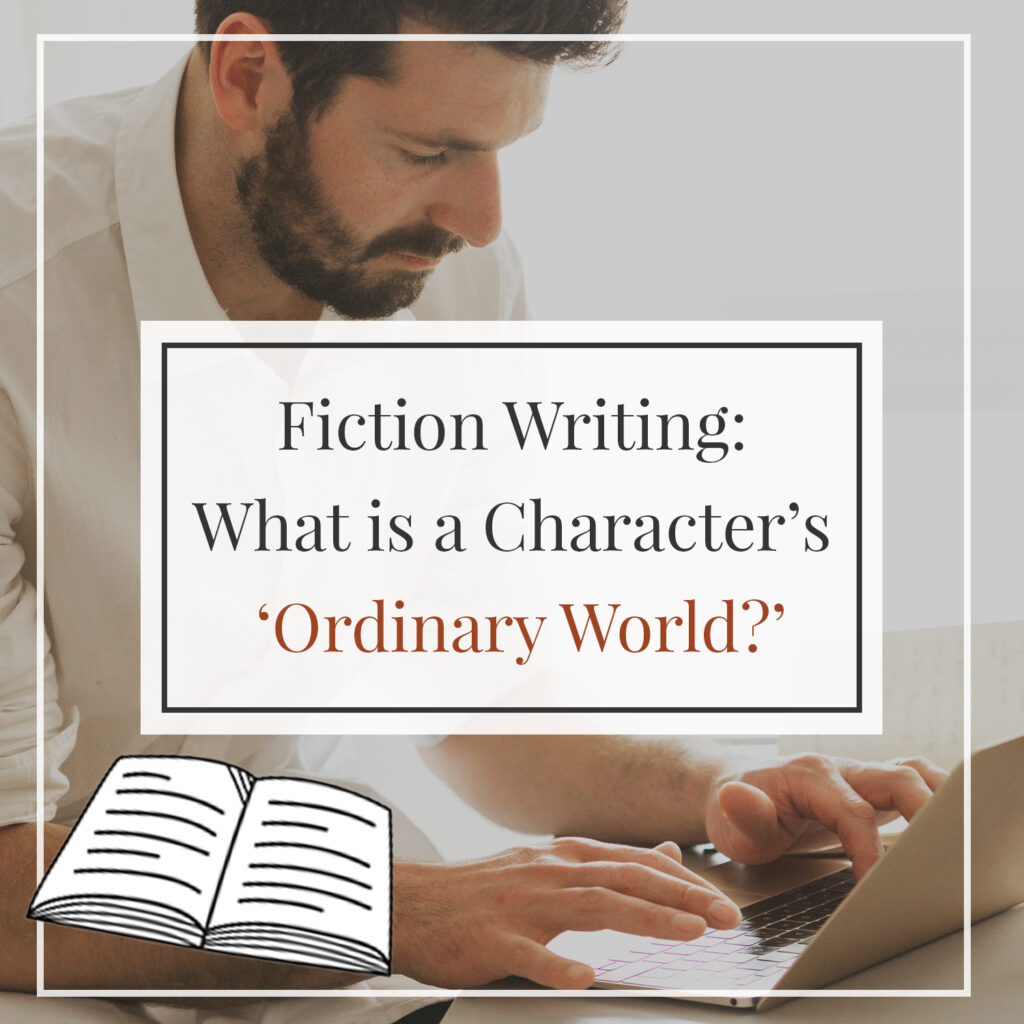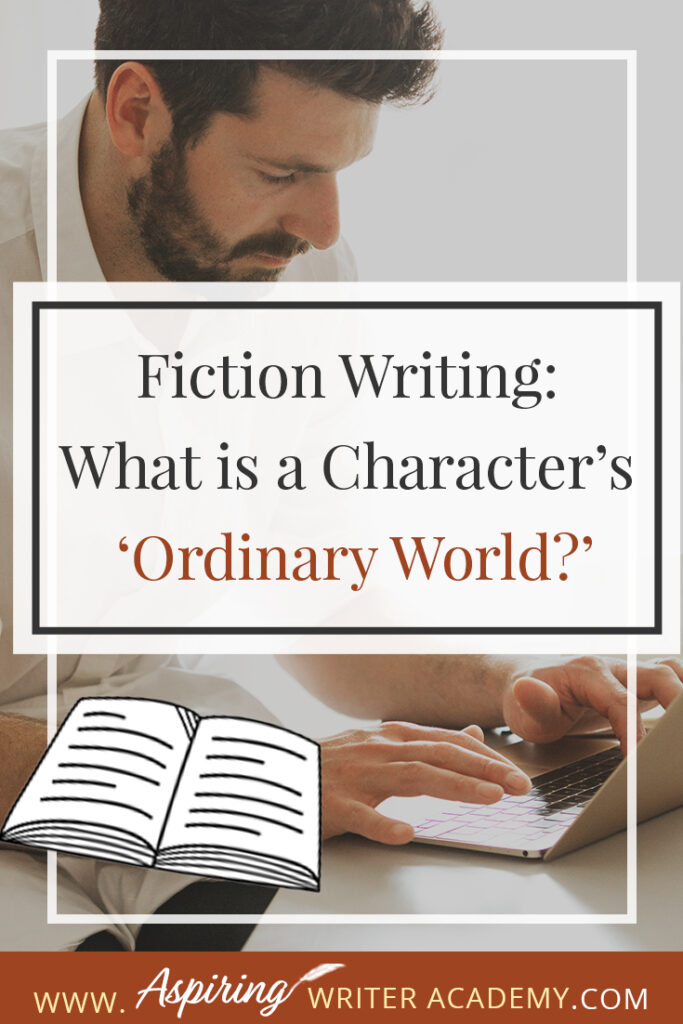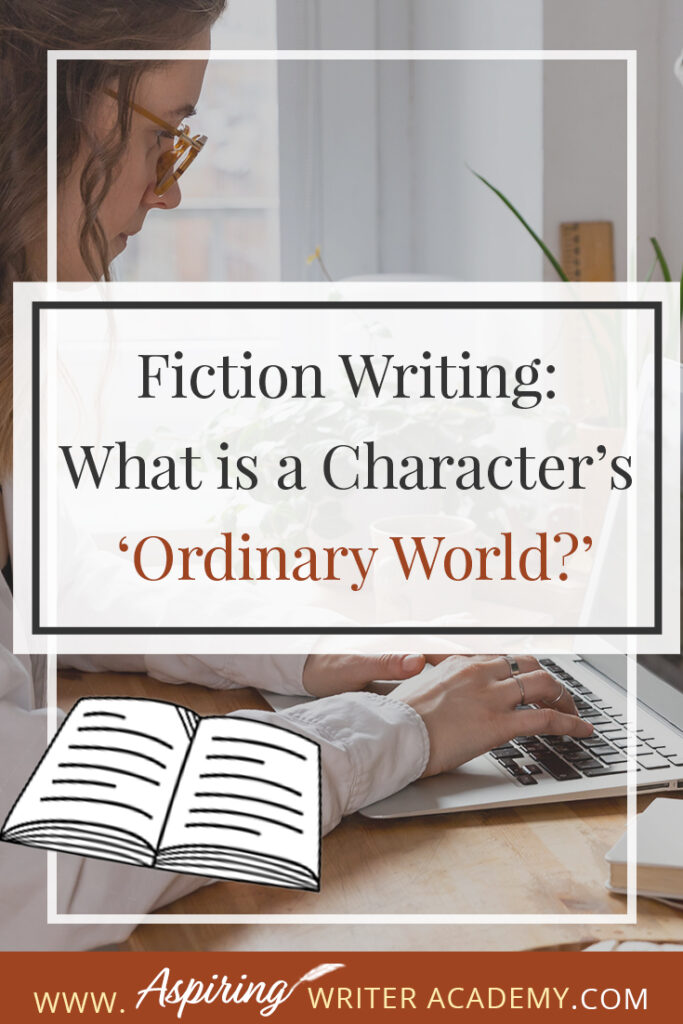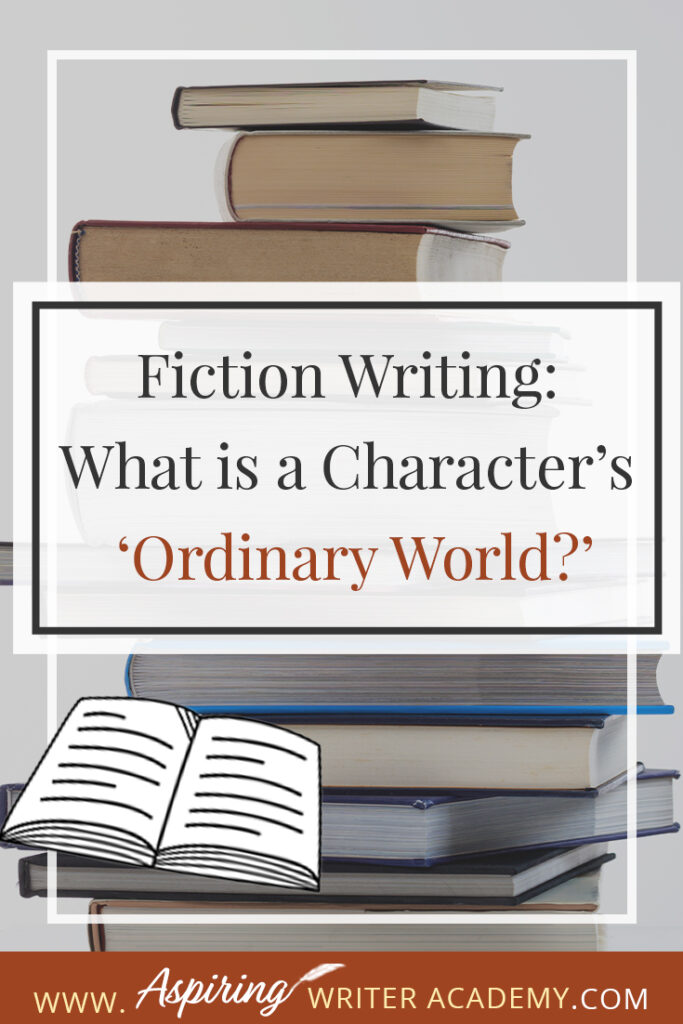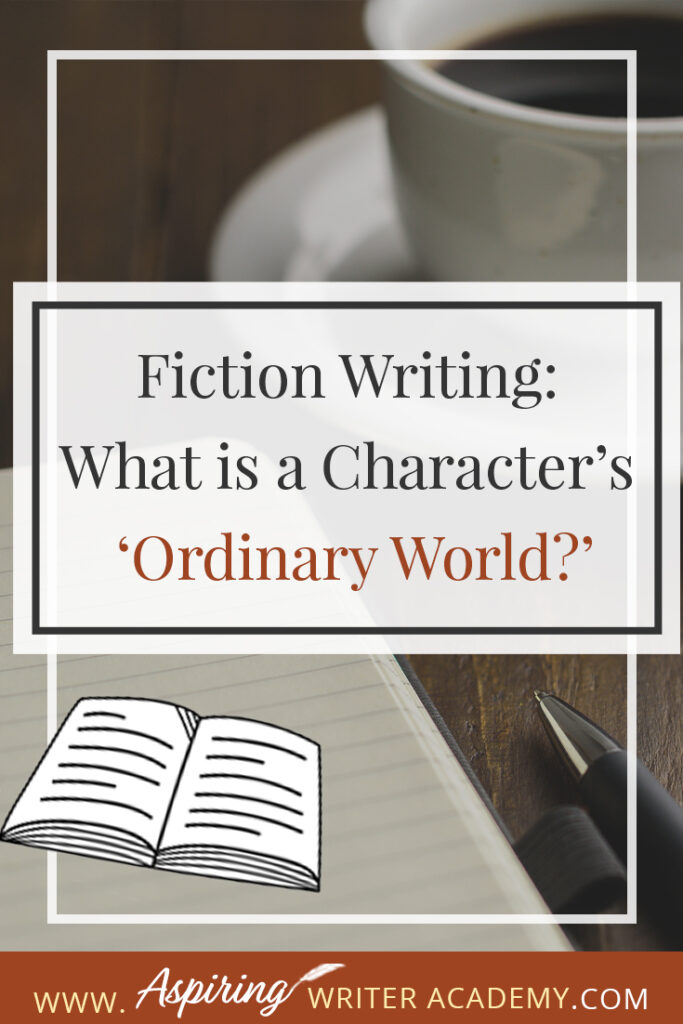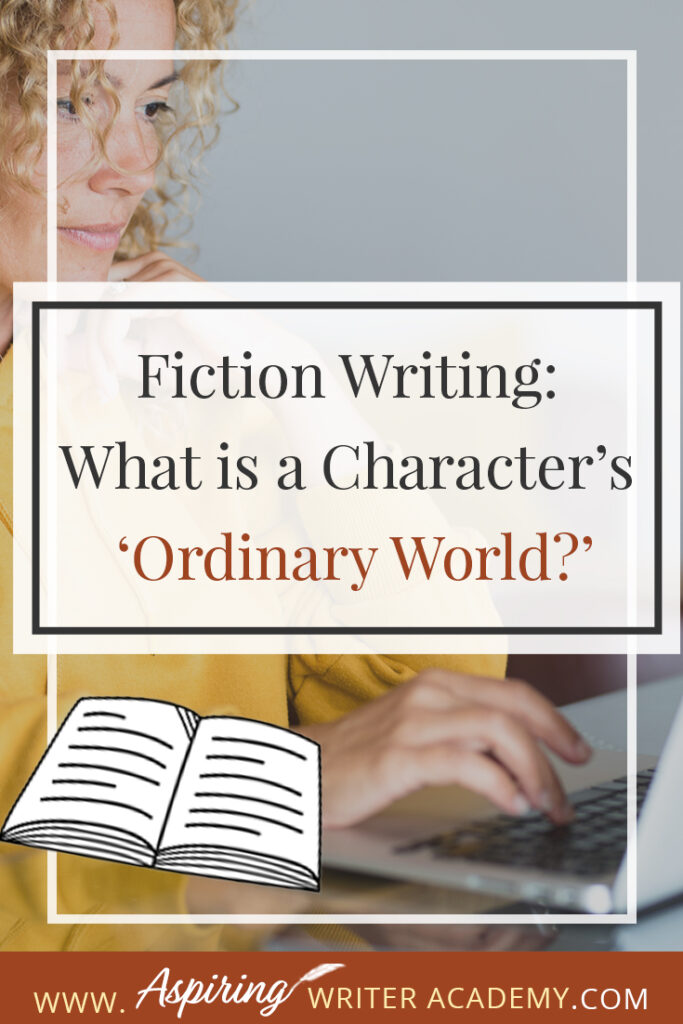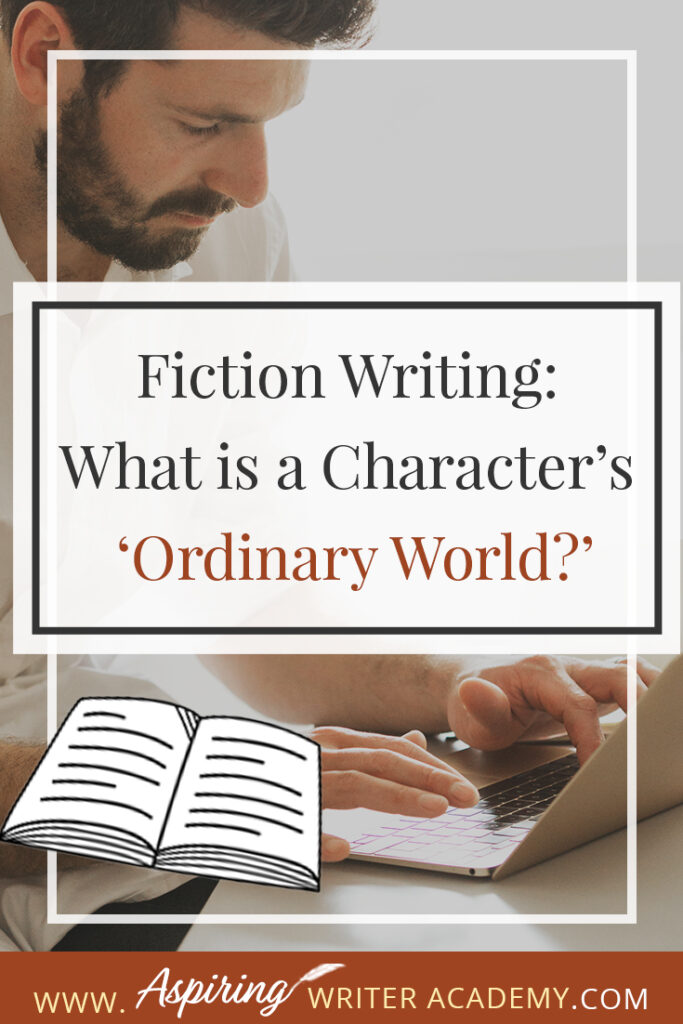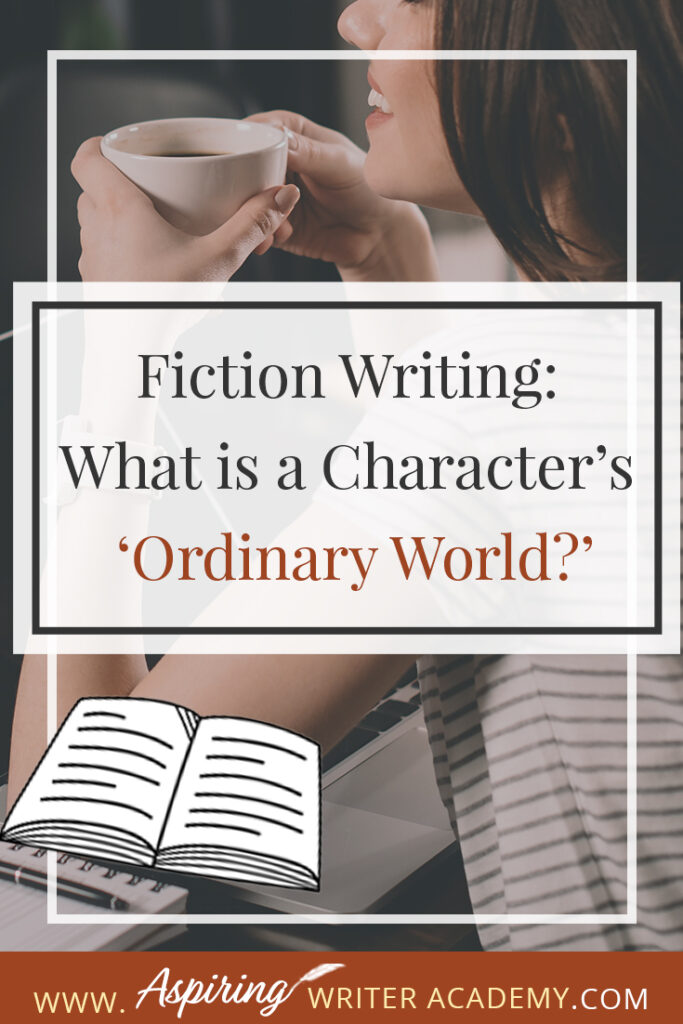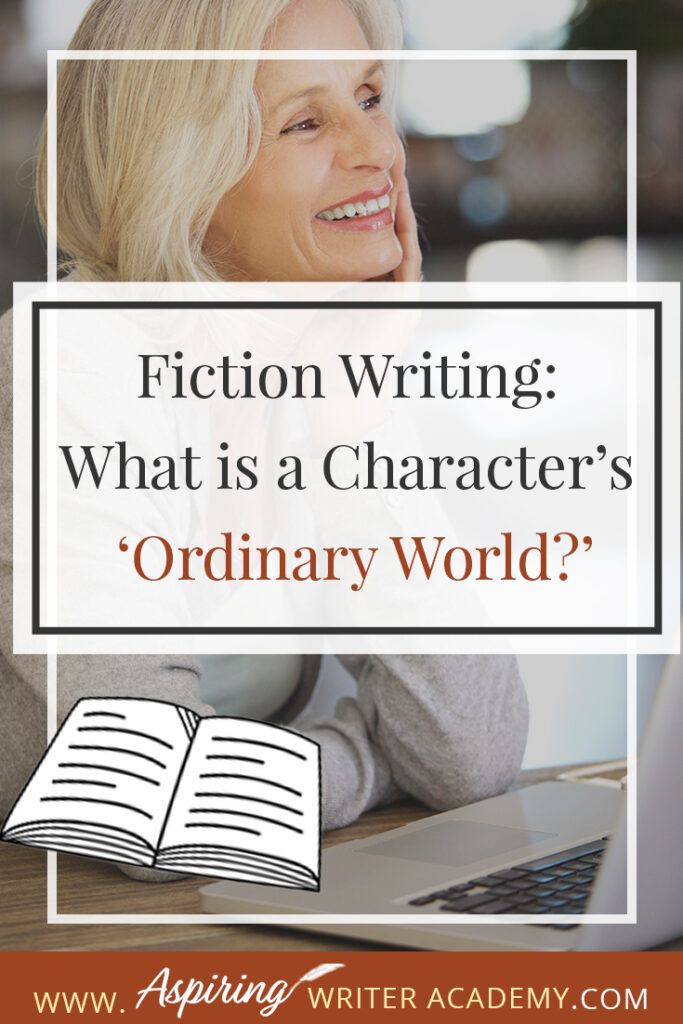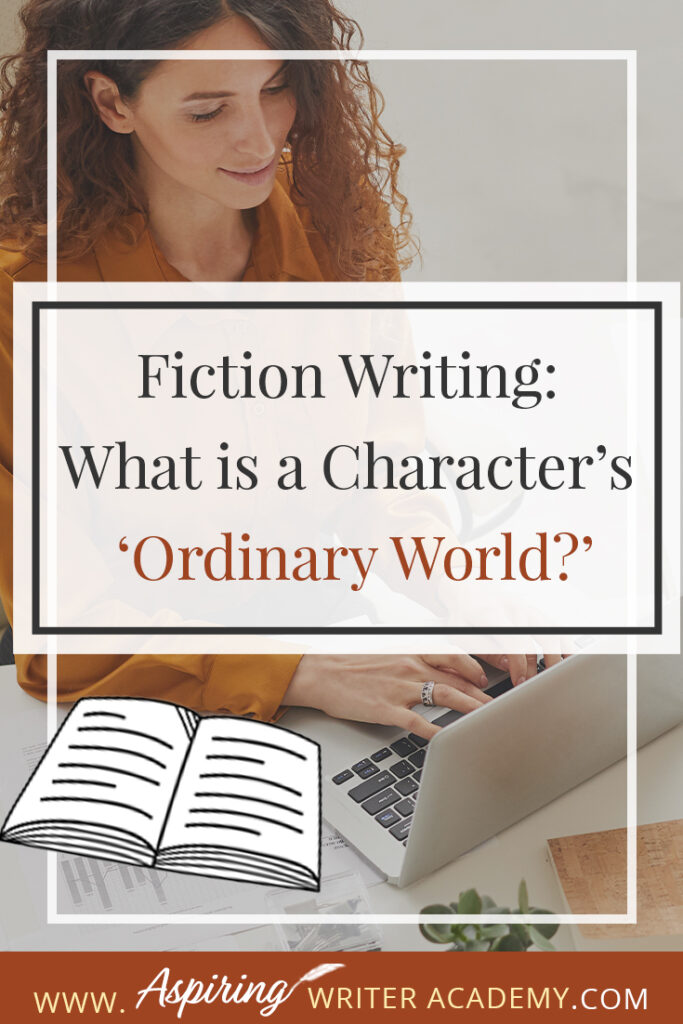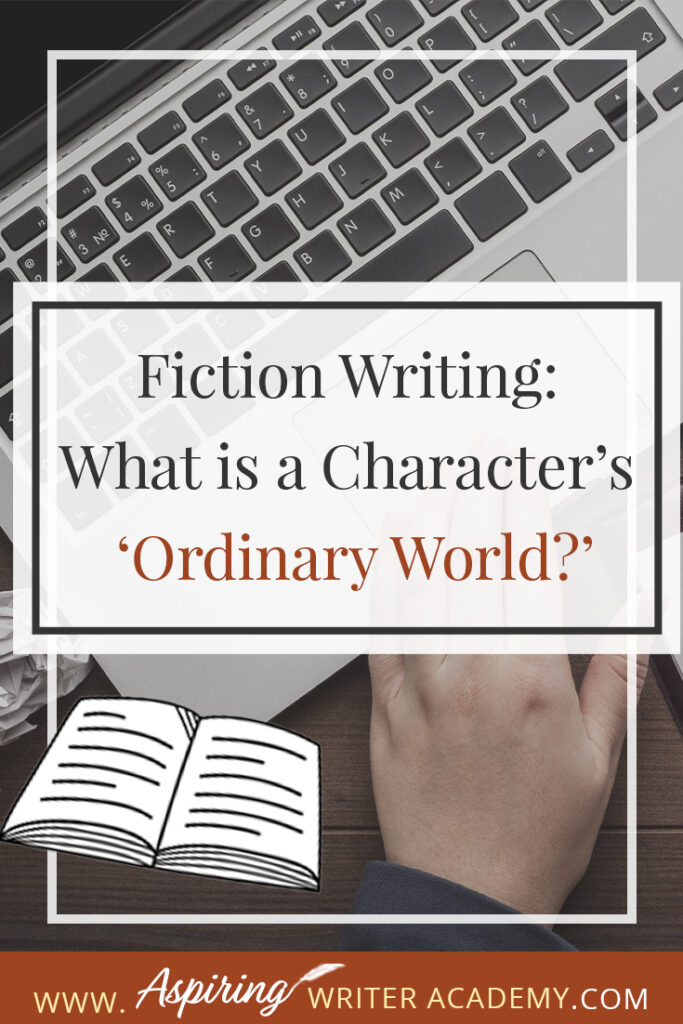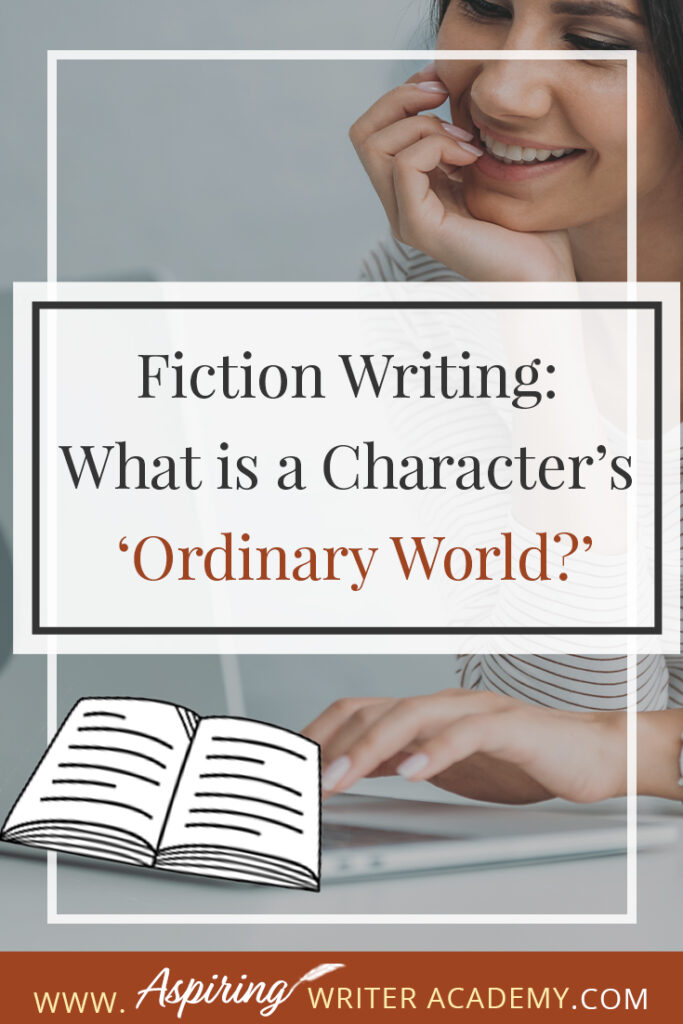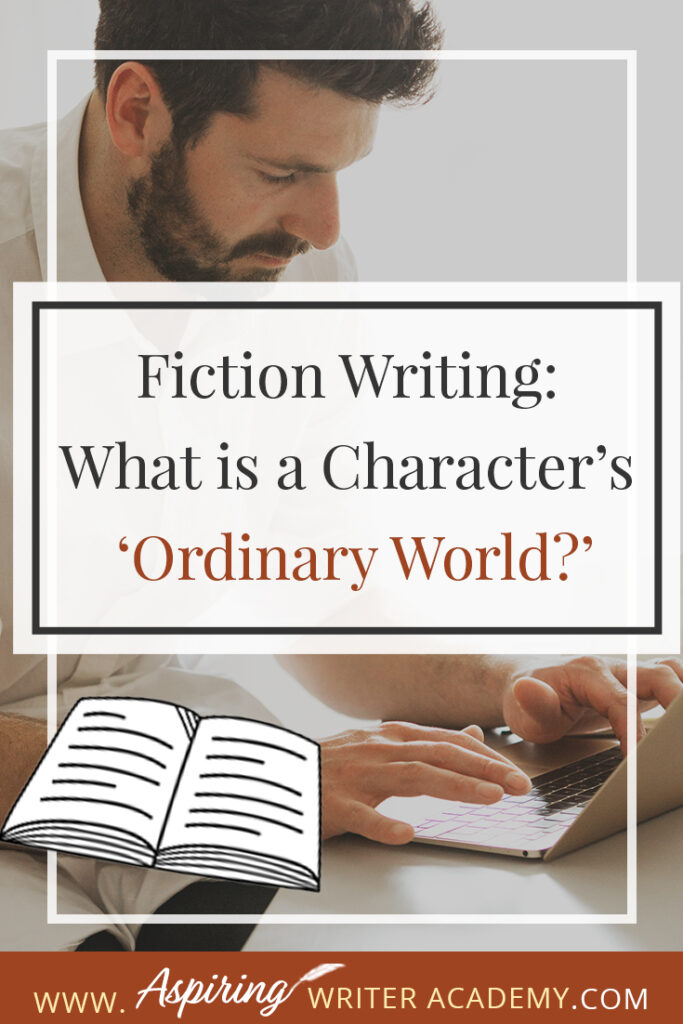Fiction Writing: What is a Character’s ‘Ordinary World?’
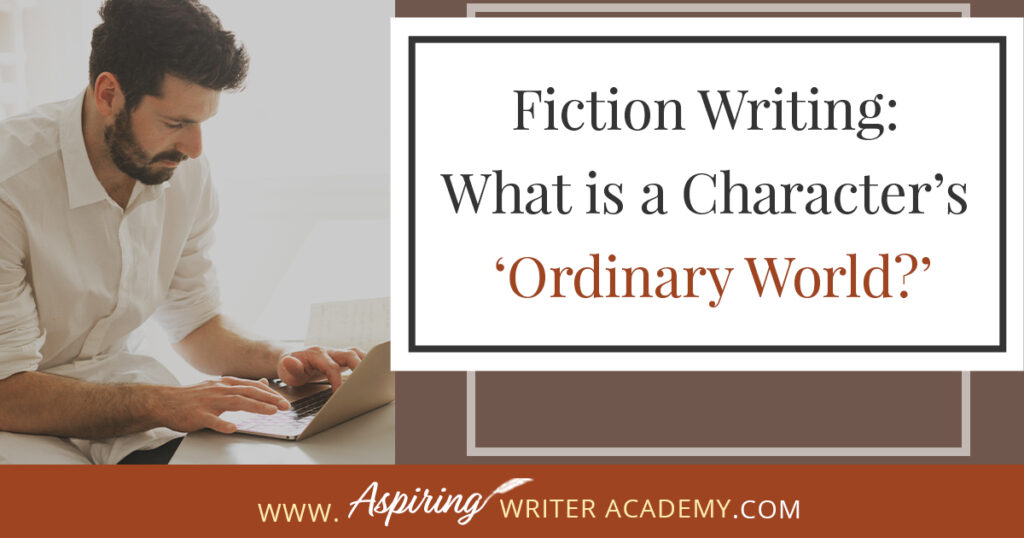
Does your character live in a world where animals talk? Does he fly a spaceship to work? Or does his ‘ordinary world’ include monsters or a unique culture with specific rules and questionable beliefs?
In our post, Fiction Writing: What is a Character’s ‘Ordinary World?’ we show you how to give the reader the set-up pieces needed to understand your character and how he fits in with his environment before the external events of the plot unfold.
What is a Character’s ‘Ordinary World’ in a Fictional Novel?
‘Ordinary World’ is a term used by fiction writers that refers to the set-up pieces at the beginning of a story to let the reader know: What kind of a story is this?
In the post below we will discuss:
- Setting of the Ordinary World
- The Culture & Accepted Norms
- Everyday Life for Your Characters
1) Setting of the Ordinary World
It is important to show the main character (protagonist) of your fictional story interacting with his normal everyday ordinary world at the beginning of your story to inform the reader where and when the story is set. This locks in a starting point to orient the reader before the story takes off in a million other directions. The setting provides basic understanding of the story world and what to expect from this particular place.
What does this character believe is ‘ordinary?’
- Location: What place, town, city, state, country, planet, or multi-verse is this fictional story set? What does it look like? What are the 5 senses experienced in this place? (What does your character see, hear, smell, taste, feel, as well as lighting and temperature? What colors are present?)
- Time Period: Is the story set in the past, present, future, or an unknown time in a different universe or dimension? What is the year, month, day, season? Is time calculated differently in this ‘world’ than what the reader would expect? How can you use clothing, accessories, weather, nature, or other details of the setting to SHOW the reader the time period of your fictional story?
- General Setting / Focus: Is it a war story, a football story, a teenage coming-of-age story, a fantasy, futuristic or dystopian story? What kind of story is it? What setting is at the center of this story? Is it a story about horse racing? Or a historical novel set in the Gilded Age? Is the story set at a bakery or a seaside resort by the beach? What accessories, furnishings, and items would one expect to see in such a setting?
In the opening scenes of your novel, how can you SHOW the reader these details without telling them? While you might italicize the city and date above your opening paragraph in a historical novel to allow your reader to jump right into the story, the author should also blend other setting details into the opening scenes to bring the setting to life.
How can your character interact with the setting? What can you show your character doing to emphasize certain aspects of the setting that might be important later?
2) The Culture & Accepted Norms
What other people, beings, animals, or creatures exist in this ordinary world? What does your character take for granted as being normal?
Is it common to see flying monkeys or werewolves or vampires? Is it accepted that the rodeo cowboys will congregate at a specific ranch after each event? Do certain children of the community get sent to Spy School? Or a school for wizards and witches like in the Harry Potter series by J.K. Rowling? Is it the norm for the elder ladies in your story to all gather for tea at a specific restaurant on Tuesdays at 8:00 am? Or is it accepted that these ladies gather for NFL football games and root for their favorite team’s quarterback?
Is it a war story, a football story, a teenage coming-of-age story, a fantasy, futuristic or dystopian story? What kind of story is it? What setting is at the center of this story?
What customs or rituals do the characters in this fictional story believe is normal or ‘ordinary?’ What is the form of government? How are certain people selected for special events? (Example: The Hunger Games by Suzanne Collins or Divergent by Veronica Roth.) Does the society in which your character lives believe people should not eat meat? Why? What is the reasoning behind these customs or explanation for how they came into being?
What is expected by the inhabitants of this story-world that may be quite unexpected to the reader? How can you hint that the setting of the ‘ordinary world’ may cause conflict for your character as the story unfolds? Is the main character at odds with his ‘ordinary world?’ How does your character feel about it? And why?
3) Everyday Life for Your Characters
The ‘ordinary world’ sets the standard for what life is like for your characters before the life-changing events of the plot take the character off in another direction. The beginning of the story, set in the character’s ordinary world, shows us who this character is before changes start taking place.
The story journey often changes your main character from who he was at the beginning to who he is at the end. This is referred to as a ‘character arc.’
So who is your main character at the beginning of the story? How can the setting of his ‘ordinary world’ help SHOW his characteristics, habits, and personality? How can this setting show his strengths and weaknesses?
What does your character normally do when he gets up in the morning? What does he wear? What does he eat? How does he get to school or work? (mode of transportation)
Who are his family members, pets, and friends?
Opening Scene Example:
- A strong, highly skilled helicopter rescue pilot is shown aiding in the rescue of a young girl trapped in a car on the edge of a cliff. (From the 2015 movie, San Andreas starring Dwayne Johnson.) The rockslide that hurls her car off the road could be from a minor earthquake which will lead to greater quakes throughout the movie, hinting at the overall setting right from the get-go. This is a disaster movie featuring the possible damage that could be caused by the San Andreas fault in California. (Even if some of the special effects appear unrealistic.)
Not only is the overall setting of the ‘ordinary world’ set up but also who the main character is and how he is able to interact with this world. By showing how capable the main character (rescue pilot) is in the beginning, it is believable that he can perform the needed actions to help others during the rest of the story. We see his skill by how he handles the helicopter and interacts with his team of co-workers. We also see through dialogue with others the weakness he needs to overcome by the end of this story for character growth—he is still traumatized by the drowning of his daughter who he could not rescue. Ironically, at the end of this story, he needs to face the past and overcome his fear to save his other daughter from drowning as well.
- Similarly, if your character is a doctor, you might want to show him performing surgery at the hospital where he works or interacting with patients, especially if his skill as a doctor is going to be needed later in the story. Foreshadow or hint at important details of the setting of the ‘ordinary world’ that the reader should know.
- Another example can be found in J.R.R. Tolkien’s The Hobbit, where the opening scenes show Bilbo comfortably residing in his hobbit hole in the Shire, a fantasy Middle-Earth community of short-statured peaceful folk who love gardening, eating multiple meals, and in Bilbo’s case—smoking a pipe and studying maps. However, he absolutely is not the type of hobbit who goes on adventures, no sir-ee! Not him! So, guess what Bilbo will have to do during this story? Yes—go on an adventure that changes who he is and everything he believes.
The One-Page Journal Entry (A page from your character’s diary)
A great exercise to generate ideas for your protagonist’s ‘ordinary world’ is to write a one-page journal entry from your character’s point of view. What is his or her ordinary day like from beginning to end? What did the character do? Who did he meet or talk to on the phone? What was the subject matter? How does your character feel about others or current events or his environment? What bothers him or makes him grumble? What makes him happy?
Feel free to add your character’s thoughts and feelings into this journal entry to make it as personal as possible. Perhaps even add a few bits of dialogue. Does this character talk to his pet? What habits, quirks, personality traits can you come up with to insert into this journal entry to SHOW who this character is? Is he clumsy? Have him trip over something. How can the character’s ‘ordinary world’ help expose his strengths and weaknesses?
What conflicts can realistically rise from this character’s ‘ordinary world’ or how can the introduction of danger jeopardize this ‘ordinary world?’
Insert some of your character’s journal entry into the opening of your story!
We hope you have enjoyed Fiction Writing: What is a Character’s ‘Ordinary World?’ and have gained some valuable tips to set up the beginning of your fictional story in a way that shows who your characters are before the life-changing events begin.
If you have any questions or would like to leave a comment below, we would love to hear from you!
If you like more help developing your story, you may wish to download our Free Brainstorming Your Story Idea Worksheet
Do you find it difficult to create compelling antagonists and villains for your stories? Do your villains feel cartoonish and unbelievable? Do they lack motivation or a specific game plan? Discover the secrets to crafting villains that will stick with your readers long after they finish your story, with our How to Create Antagonists & Villains Workbook.
This 32-page instructional workbook is packed with valuable fill-in-the-blank templates and practical advice to help you create memorable and effective antagonists and villains. Whether you're a seasoned writer or just starting out, this workbook will take your writing to the next level.
Our Goal for Aspiring Writer Academy is to help people learn how to write quality fiction, teach them to publish and promote their work, and to give them the necessary tools to pursue a writing career.

ENTER YOUR EMAIL BELOW
TO GET YOUR FREE
"Brainstorming Your Story Idea Worksheet"
7 easy fill-in-the-blank pages,
+ 2 bonus pages filled with additional story examples.
A valuable tool to develop story plots again and again.
Other Blog Posts You May Like
How to Create S.M.A.R.T. Goals to Keep Your Writing on Track
How to Use Setting to Intensify Your Fictional Scenes
The Pros and Cons of Writing Holiday Fiction (Collections & Anthologies)
How to Research Information for a Historical Novel
Fiction Writing: Create a Storyboard to Map Out Your Scenes
Fiction Writing: How Specific Details Can Bring Your Setting to Life

is a multi-published author, speaker, and writing coach. She writes sweet contemporary, inspirational, and historical romance and loves teaching aspiring writers how to write quality fiction. Read her inspiring story of how she published her first book and launched a successful writing career.

